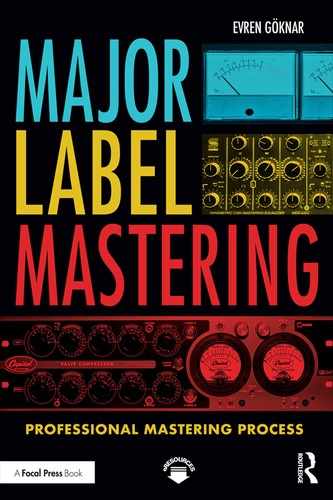Chapter 10
Before the Mastering Session
Preliminary Dialogue With the Client
Before beginning a mastering project, it’s important to discuss with the client (artist, engineer, producer, manager, or label) about their expectations, your mutual understandings of the specific genre, their current impression(s) of the recording and mixes, and some examples of successful projects that are comparable to theirs. This alleviates surprises and clarifies downstream expectations about the fidelity of the project. If they can send you a near-final mix, it is beneficial as you can verify that it is ready for mastering, or address any concerns before the mastering session. As your reputation and discography builds, clients will rely on your input before the mastering session. Although there can be variances, the most common mix issues to be aware of are over-compressed mix files that have problematic artifacts, improperly balanced frequency ranges (from inadequate room/playback acoustics), and improperly balanced vocals or instruments. Fortunately, all of these concerns can be addressed with revision notes for the mixer.
Genre-Specific Considerations
Awareness of musical genres was introduced in Chapter 1 as a subset of being an audiophile. Your clients expect that you understand and are familiar with their particular musical genre and production approaches. Your mastering work and ability to discuss concerns with your clients will benefit from this insight. There is no simple way to access a depth of knowledge about each specific genre, along with its common production techniques. Musicianship or musical ability, familiarity with artists and albums, concerts attended, and personal taste in music will affect this understanding. As such, time spent interning or working in a commercial recording studio is priceless for exposure to these production approaches. With understanding and respect for how the production team created the music, you will be able to connect with the client’s musical vision and contextualize your mastering approach accurately.
One particular benefit of my tenure at a major label is being tasked to work on a variety of musical styles that comprise the label’s catalog. Also, being in a ‘music metropolis’ like Los Angeles—with its diversity of musical styles and scenes—offers opportunities to work on a wide breadth of music. You may become known as a rock Mastering Engineer, or a hip-hop/rap Mastering Engineer, but it is beneficial to develop confidence mastering various genres of music. Each genre has different mastering characteristics: target playback level, amount of compression/limiting, frequency and instrument balances, and drums and vocal placement.
Experiment Regularly
One of the senior engineers at Capitol when I began was Bob Norberg, who developed a technique of reversing a source file in the computer and playing it backwards through his LA2A compressors to get a compressed sound without losing the leading edge of the transient attacks. Bob was known for mixing and mastering classical music, and a fan of the genre would call him and complain that in her car, quiet passages would get lost. So Bob utilized this reverse-file method to ‘lift up’ the quiet passages in classical music. This type of creativity can solve issues and successfully affect the final result, so allow time to experiment and test mastering approaches. You may discover methods or combinations of equipment that produce excellent results in the audio.
The Mastering Shoot-Out
Professional audio mastering is an extremely competitive arena. Mastering Engineers are known to vie for projects, especially those from ‘name’ artists, record labels, or producers. In this context, it is common to be asked to shoot-out a song first before a final decision is made regarding who will do the mastering.
It’s up to you how to manage these requests. The most gentile approach is for the client to pay for the song. Short of that, many Mastering Engineers offer a free snippet or even an entire song. This can feel like considerable pressure, so it is critical to initially discuss particulars about the project and the sound the client is after. Take solace in the fact that your name and reputation allow for you to contend in such circumstances. Shoot-outs are naturally done before the session, but on rare occasions or with larger budget projects, an album may be sent to two or more Mastering Engineers simultaneously and the production team subsequently chooses its favorite master.
PRICING
Pricing is an often-ignored aspect of music technology education, but exceedingly important to grasp, as budget discussions precede most mastering sessions. If you work with an office or administrative staff, they can oversee this aspect, but still the subject bears addressing. Make sure that pricing is simple but covers all eventualities and delivery requests (known as ‘parts’). For example, one good approach is to set a per-song rate and an analogous hourly rate for revisions. Include one free revision, client-revised mixes at half price, alternate mixes (instrumental, TV, a cappella, etc.) at half price, and a separate stem mastering price. Also include final master pricing (DDP, PMCD), or special additional file pricing (MFiT, Spotify). You can always make a package deal, but it is difficult to go back into a ‘priced’ project without possibly annoying the client.
Conclusion
The success of a mastering session begins with client communication. A clear understanding of the production team’s vision for the project will streamline the mastering session and your approach. Familiarity with the musical genre, and related project discourse before implementing The Five Step Mastering Process from Part III, will affect the success of the project. By communicating your understanding of the music, and improving the fidelity of the mix, you will engender trust and respect, which lead to referrals and repeat projects.
